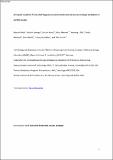An Arp2/3 Nucleated F-Actin Shell Fragments Nuclear Membranes at Nuclear Envelope Breakdown in Starfish Oocytes
Author(s)
Mori, Masashi; Kondo, Hiroshi; Monnier, Nilah; Falk, Henning J.; Machado, Pedro; Bathe, Mark; Somogyi, Kalman; Nedelec, Francois; Lenart, Peter; ... Show more Show less
DownloadMain article (17.86Mb)
OPEN_ACCESS_POLICY
Open Access Policy
Creative Commons Attribution-Noncommercial-Share Alike
Terms of use
Metadata
Show full item recordAbstract
Animal cells disassemble and reassemble their nuclear envelopes (NEs) upon each division. Nuclear envelope breakdown (NEBD) serves as a major regulatory mechanism by which mixing of cytoplasmic and nuclear compartments drives the complete reorganization of cellular architecture, committing the cell for division. Breakdown is initiated by phosphorylation-driven partial disassembly of the nuclear pore complexes (NPCs), increasing their permeability but leaving the overall NE structure intact. Subsequently, the NE is rapidly broken into membrane fragments, defining the transition from prophase to prometaphase and resulting in complete mixing of cyto- and nucleoplasm. However, the mechanism underlying this rapid NE fragmentation remains largely unknown. Here, we show that NE fragmentation during NEBD in starfish oocytes is driven by an Arp2/3 complex-nucleated F-actin “shell” that transiently polymerizes on the inner surface of the NE. Blocking the formation of this F-actin shell prevents membrane fragmentation and delays entry of large cytoplasmic molecules into the nucleus. We observe spike-like protrusions extending from the F-actin shell that appear to “pierce” the NE during the fragmentation process. Finally, we show that NE fragmentation is essential for successful reproduction, because blocking this process in meiosis leads to formation of aneuploid eggs.
Date issued
2014-06Department
Massachusetts Institute of Technology. Department of Biological Engineering; Massachusetts Institute of Technology. Laboratory for Computational Cell Biology & BiophysicsJournal
Current Biology
Publisher
Elsevier
Citation
Mori, Masashi, Kalman Somogyi, Hiroshi Kondo, Nilah Monnier, Henning J. Falk, Pedro Machado, Mark Bathe, François Nedelec, and Peter Lenart. “An Arp2/3 Nucleated F-Actin Shell Fragments Nuclear Membranes at Nuclear Envelope Breakdown in Starfish Oocytes.” Current Biology 24, no. 12 (June 2014): 1421–1428.
Version: Author's final manuscript
ISSN
09609822
1879-0445